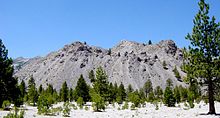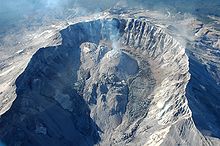


In volcanology, a lava dome is a circular, mound-shaped protrusion resulting from the slow extrusion of viscous lava from a volcano. Dome-building eruptions are common, particularly in convergent plate boundary settings. Around 6% of eruptions on Earth form lava domes. The geochemistry of lava domes can vary from basalt (e.g. Semeru, 1946) to rhyolite (e.g. Chaiten, 2010) although the majority are of intermediate composition (such as Santiaguito, dacite-andesite, present day) The characteristic dome shape is attributed to high viscosity that prevents the lava from flowing very far. This high viscosity can be obtained in two ways: by high levels of silica in the magma, or by degassing of fluid magma. Since viscous basaltic and andesitic domes weather fast and easily break apart by further input of fluid lava, most of the preserved domes have high silica content and consist of rhyolite or dacite.
Existence of lava domes has been suggested for some domed structures on the Moon, Venus, and Mars, e.g. the Martian surface in the western part of Arcadia Planitia and within Terra Sirenum.
Dome dynamics

Lava domes evolve unpredictably, due to non-linear dynamics caused by crystallization and outgassing of the highly viscous lava in the dome's conduit. Domes undergo various processes such as growth, collapse, solidification and erosion.
Lava domes grow by endogenic dome growth or exogenic dome growth. The former implies the enlargement of a lava dome due to the influx of magma into the dome interior, and the latter refers to discrete lobes of lava emplaced upon the surface of the dome. It is the high viscosity of the lava that prevents it from flowing far from the vent from which it extrudes, creating a dome-like shape of sticky lava that then cools slowly in-situ. Spines and lava flows are common extrusive products of lava domes. Domes may reach heights of several hundred meters, and can grow slowly and steadily for months (e.g. Unzen volcano), years (e.g. Soufrière Hills volcano), or even centuries (e.g. Mount Merapi volcano). The sides of these structures are composed of unstable rock debris. Due to the intermittent buildup of gas pressure, erupting domes can often experience episodes of explosive eruption over time. If part of a lava dome collapses and exposes pressurized magma, pyroclastic flows can be produced. Other hazards associated with lava domes are the destruction of property from lava flows, forest fires, and lahars triggered from re-mobilization of loose ash and debris. Lava domes are one of the principal structural features of many stratovolcanoes worldwide. Lava domes are prone to unusually dangerous explosions since they can contain rhyolitic silica-rich lava.
Characteristics of lava dome eruptions include shallow, long-period and hybrid seismicity, which is attributed to excess fluid pressures in the contributing vent chamber. Other characteristics of lava domes include their hemispherical dome shape, cycles of dome growth over long periods, and sudden onsets of violent explosive activity. The average rate of dome growth may be used as a rough indicator of magma supply, but it shows no systematic relationship to the timing or characteristics of lava dome explosions.
Gravitational collapse of a lava dome can produce a block and ash flow.
Related landforms
Cryptodomes

A cryptodome (from the Greek κρυπτός, kryptos, "hidden, secret") is a dome-shaped structure created by accumulation of viscous magma at a shallow depth. One example of a cryptodome was in the May 1980 eruption of Mount St. Helens, where the explosive eruption began after a landslide caused the side of the volcano to collapse, leading to explosive decompression of the subterranean cryptodome.
Lava spine/Lava spire
Main article: Lava spine
A lava spine or lava spire is a growth that can form on the top of a lava dome. A lava spine can increase the instability of the underlying lava dome. A recent example of a lava spine is the spine formed in 1997 at the Soufrière Hills Volcano on Montserrat.
Lava coulées

Coulées (or coulees) are lava domes that have experienced some flow away from their original position, thus resembling both lava domes and lava flows.
The world's largest known dacite flow is the Chao dacite dome complex, a huge coulée flow-dome between two volcanoes in northern Chile. This flow is over 14 kilometres (8.7 mi) long, has obvious flow features like pressure ridges, and a flow front 400 metres (1,300 ft) tall (the dark scalloped line at lower left). There is another prominent coulée flow on the flank of Llullaillaco volcano, in Argentina, and other examples in the Andes.
Examples of lava domes
Main article: List of lava domes| Name of lava dome | Country | Volcanic area | Composition | Last eruption or growth episode |
|---|---|---|---|---|
| Chaitén lava dome | Chile | Southern Volcanic Zone | Rhyolite | 2009 |
| Ciomadul lava domes | Romania | Carpathians | Dacite | Pleistocene |
| Cordón Caulle lava domes | Chile | Southern Volcanic Zone | Rhyodacite to Rhyolite | Holocene |
| Galeras lava dome | Colombia | Northern Volcanic Zone | Unknown | 2010 |
| Katla lava dome | Iceland | Iceland hotspot | Rhyolite | 1999 onwards |
| Lassen Peak | United States | Cascade Volcanic Arc | Dacite | 1917 |
| Black Butte (Siskiyou County, California) | United States | Cascade Volcanic Arc | Dacite | 9500 BP |
| Bridge River Vent lava dome | Canada | Cascade Volcanic Arc | Dacite | ca. 300 BC |
| La Soufrière lava dome | Saint Vincent and the Grenadines | Lesser Antilles Volcanic Arc | 2021 | |
| Mount Merapi lava dome | Indonesia | Sunda Arc | Unknown | 2010 |
| Nea Kameni | Greece | South Aegean Volcanic Arc | Dacite | 1950 |
| Novarupta lava dome | United States | Aleutian Arc | Rhyolite | 1912 |
| Nevados de Chillán lava domes | Chile | Southern Volcanic Zone | Dacite | 1986 |
| Puy de Dôme | France | Chaîne des Puys | Trachyte | c. 5760 BC |
| Santa María lava dome | Guatemala | Central America Volcanic Arc | Dacite | 2009 |
| Sollipulli lava dome | Chile | Southern Volcanic Zone | Andesite to Dacite | 1240 ± 50 years |
| Soufrière Hills lava dome | Montserrat | Lesser Antilles | Andesite | 2009 |
| Mount St. Helens lava domes | United States | Cascade Volcanic Arc | Dacite | 2008 |
| Torfajökull lava dome | Iceland | Iceland hotspot | Rhyolite | 1477 |
| Tata Sabaya lava domes | Bolivia | Andes | Unknown | ~ Holocene |
| Tate-iwa | Japan | Japan Arc | Dacite | Miocene |
| Tatun lava domes | Taiwan | Andesite | 648 | |
| Valles lava domes | United States | Jemez Mountains | Rhyolite | 50,000-60,000 BP |
| Wizard Island lava dome | United States | Cascade Volcanic Arc | Rhyodacite | 2850 BC |
References
- ^ Calder, Eliza S.; Lavallée, Yan; Kendrick, Jackie E.; Bernstein, Marc (2015). The Encyclopedia of Volcanoes. Elsevier. pp. 343–362. doi:10.1016/b978-0-12-385938-9.00018-3. ISBN 9780123859389.
- ^ Fink, Jonathan H.; Anderson, Steven W. (2001). "Lava Domes and Coulees". In Sigursson, Haraldur (ed.). Encyclopedia of Volcanoes. Academic Press. pp. 307–19.
- Rampey, Michael L.; Milam, Keith A.; McSween, Harry Y.; Moersch, Jeffrey E.; Christensen, Philip R. (28 June 2007). "Identity and emplacement of domical structures in the western Arcadia Planitia, Mars". Journal of Geophysical Research. 112 (E6): E06011. Bibcode:2007JGRE..112.6011R. doi:10.1029/2006JE002750.
- Brož, Petr; Hauber, Ernst; Platz, Thomas; Balme, Matt (April 2015). "Evidence for Amazonian highly viscous lavas in the southern highlands on Mars". Earth and Planetary Science Letters. 415: 200–212. Bibcode:2015E&PSL.415..200B. doi:10.1016/j.epsl.2015.01.033.
- Melnik, O; Sparks, R. S. J. (4 November 1999), "Nonlinear dynamics of lava dome extrusion" (PDF), Nature, 402 (6757): 37–41, Bibcode:1999Natur.402...37M, doi:10.1038/46950, S2CID 4426887
- Darmawan, Herlan; Walter, Thomas R.; Troll, Valentin R.; Budi-Santoso, Agus (2018-12-12). "Structural weakening of the Merapi dome identified by drone photogrammetry after the 2010 eruption". Natural Hazards and Earth System Sciences. 18 (12): 3267–3281. Bibcode:2018NHESS..18.3267D. doi:10.5194/nhess-18-3267-2018. ISSN 1561-8633.
- Darmawan, Herlan; Troll, Valentin R.; Walter, Thomas R.; Deegan, Frances M.; Geiger, Harri; Heap, Michael J.; Seraphine, Nadhirah; Harris, Chris; Humaida, Hanik; Müller, Daniel (2022-02-25). "Hidden mechanical weaknesses within lava domes provided by buried high-porosity hydrothermal alteration zones". Scientific Reports. 12 (1): 3202. Bibcode:2022NatSR..12.3202D. doi:10.1038/s41598-022-06765-9. ISSN 2045-2322. PMC 8881499. PMID 35217684.
- Heap, Michael J.; Troll, Valentin R.; Kushnir, Alexandra R. L.; Gilg, H. Albert; Collinson, Amy S. D.; Deegan, Frances M.; Darmawan, Herlan; Seraphine, Nadhirah; Neuberg, Juergen; Walter, Thomas R. (2019-11-07). "Hydrothermal alteration of andesitic lava domes can lead to explosive volcanic behaviour". Nature Communications. 10 (1): 5063. Bibcode:2019NatCo..10.5063H. doi:10.1038/s41467-019-13102-8. ISSN 2041-1723. PMC 6838104. PMID 31700076.
- Parfitt, E.A.; Wilson, L (2008), Fundamentals of Physical Volcanology, Massachusetts: Blackwell Publishing, p. 256
- Sparks, R.S.J. (August 1997), "Causes and consequences of pressurisation in lava dome eruptions", Earth and Planetary Science Letters, 150 (3–4): 177–189, Bibcode:1997E&PSL.150..177S, doi:10.1016/S0012-821X(97)00109-X
- Newhall, C.G.; Melson., W.G. (September 1983), "Explosive activity associated with the growth of volcanic domes", Journal of Volcanology and Geothermal Research, 17 (1–4): 111–131, Bibcode:1983JVGR...17..111N, doi:10.1016/0377-0273(83)90064-1
- Cole, Paul D.; Neri, Augusto; Baxter, Peter J. (2015). "Chapter 54 – Hazards from Pyroclastic Density Currents". In Sigurdsson, Haraldur (ed.). Encyclopedia of Volcanoes (2nd ed.). Amsterdam: Academic Press. pp. 943–956. doi:10.1016/B978-0-12-385938-9.00037-7. ISBN 978-0-12-385938-9.
- "USGS: Volcano Hazards Program Glossary - Cryptodome". volcanoes.usgs.gov. Retrieved 2018-06-23.
- "USGS: Volcano Hazards Program CVO Mount St. Helens". volcanoes.usgs.gov. Archived from the original on 2018-05-28. Retrieved 2018-06-23.
- Chao dacite dome complex at NASA Earth Observatory
- Coulées! by Erik Klemetti, an assistant professor of Geosciences at Denison University.
- Eyjafjallajökull and Katla: restless neighbours
- "Shasta". Volcano World. Oregon State University. 2000. Retrieved 30 April 2020.
- "Soufrière St. Vincent volcano (West Indies, St. Vincent): twice length and volume of new lava dome since last update". www.volcanodiscovery.com. Retrieved 2021-04-08.
- Goto, Yoshihiko; Tsuchiya, Nobutaka (July 2004). "Morphology and growth style of a Miocene submarine dacite lava dome at Atsumi, northeast Japan". Journal of Volcanology and Geothermal Research. 134 (4): 255–275. Bibcode:2004JVGR..134..255G. doi:10.1016/j.jvolgeores.2004.03.015.
- "Tatun Volcanic Group". Global Volcanism Program, Smithsonian Institution. 2023-10-11. Retrieved 2023-11-27.
- Map of Post-Caldera Volcanism and Crater Lake Archived 2020-08-04 at the Wayback Machine USGS Cascades Volcano Observatory. Retrieved 2014-01-31.
External links
| Earth's landforms | |
|---|---|
| List of landforms | |
| Mountainous | |
| Continental plain | |
| Fluvial | |
| Glacial | |
| Oceanic and coastal landforms | |
| Volcanic | |
| Aeolian | |
| Artificial | |
| |
